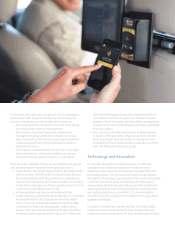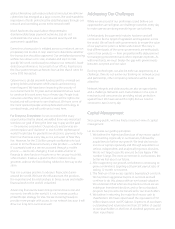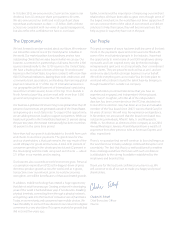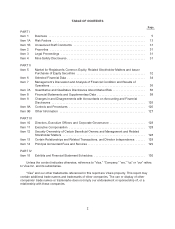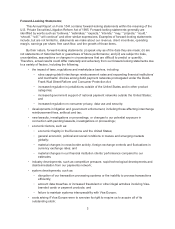Visa 2013 Annual Report Download - page 15
Download and view the complete annual report
Please find page 15 of the 2013 Visa annual report below. You can navigate through the pages in the report by either clicking on the pages listed below, or by using the keyword search tool below to find specific information within the annual report.
A typical Visa transaction begins when the account holder presents his or her Visa-branded card
or payment product to a merchant as payment for goods or services. The transaction information is
then transmitted electronically to the acquirer and routed through VisaNet to the issuer for
authorization. Following authorization, a clearing file containing the final transaction data is submitted
from the acquirer and processed for final settlement between the issuer and acquirer. The following
diagram illustrates the processing steps involved in a typical transaction on VisaNet.
Our operating revenues are comprised principally of service revenues, data processing revenues
and international transaction revenues, and are reduced by costs incurred under client incentive
arrangements. The Company has one reportable segment, Payment Services.
•Service revenues. Service revenues consist of revenues earned for providing financial
institution clients with support services for the delivery of Visa-branded payment products and
solutions. Service revenues are primarily generated from payments volume on Visa-branded
cards and payment products for purchased goods and services.
•Data processing revenues. Data processing revenues consist of revenues earned for
authorization, clearing, settlement, network access and other maintenance and support
services that facilitate transaction and information processing among our financial institution
clients globally and with Visa Europe. Data processing revenues are primarily generated from
the number of transactions we process.
•International transaction revenues. International transaction revenues consist of revenues
earned for cross-border transaction processing and currency conversion activities. Cross-
border transactions arise when the country of origin of the issuer is different from that of the
merchant. International transaction revenues are primarily generated by cross-border
payments and cash volume.
•Client incentives. Client incentives consist of long-term contracts with financial institution
clients and other business partners for various programs designed to build payments volume,
increase Visa-branded card and product acceptance and win merchant routing transactions
over our network. These incentives are primarily accounted for as reductions to operating
revenues.
7


